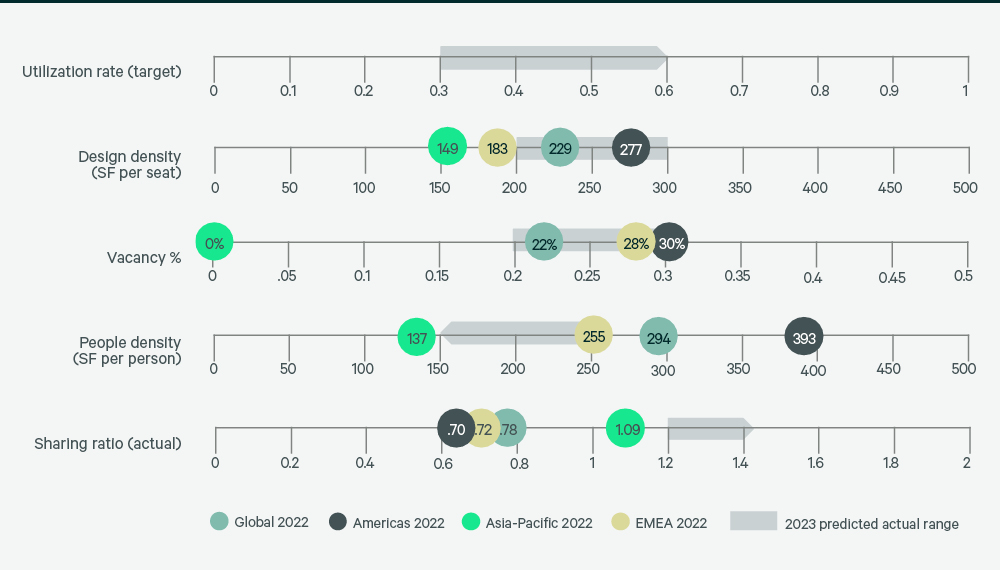Chapter 6
Outlook
2022-2023 CBRE Global Workplace & Occupancy Insights
4 Minute Read
Looking for a PDF Version?
Signals to watch in 2023
Work styles and the purpose of the office have been forever changed by the pandemic.
While the full extent of these changes are not yet measurable, patterns are emerging that will redefine workplaces in the years to come. The following questions highlight some of the signals to monitor in 2023.
Will workstations get bigger?
In 2021, workstation sizes under 35 sq. ft. (3.3 sq. m.) were the most common. In 2022, workstations ranging from 35 to 49 sq. ft. (3.3 to 4.6 sq. m.) are the most common. It’s likely that workstations will grow in size but shrink in quantity as users become more comfortable with space sharing.
Figure 24: Standard workstation sizes
Source: CBRE 2022 Occupancy Benchmarking Program.
Are private offices going away?
Thirty-one percent of respondents do not provide offices in their standards, up from 25% in 2021. Since organizations create standards for their most common space types, this suggests private offices may be falling out of favor, resulting in fewer of them as companies repurpose those spaces as reservable shared offices and provide enclosed collaboration spaces such as huddle rooms. Private spaces remain important, however, and organizations will continue to provide them in various formats.
Figure 25: Standard office sizes
Source: CBRE 2022 Occupancy Benchmarking Program.
It’s likely that workstations will grow in size but shrink in quantity.
Will hybrid work continue to grow?
Seven out of 10 respondents plan to expand their hybrid working program over the next three years. This indicates that hybrid working will become the default work model for knowledge workers globally.
Will space chargebacks be eliminated?
Twenty-eight percent of respondents are considering changes to their chargebacks in 2022. There is no evidence that chargebacks will be eliminated in the next two to three years, but the process is poised for disruption thanks to hybrid working. Recent increases in space-sharing and an emerging employee preference for collaboration areas over workspaces challenge traditional chargeback methodologies. This will likely speed the adoption of pay-as-you-go chargeback models that leverage space utilization and booking data.
Will office utilization return to pre-pandemic levels?
No for now, but eventually yes. According to a Q2 2022 utilization survey of five Fortune 500 multinational organizations, global office utilization has been slowly rising through 2022 but remains under 40%. By Q3 2023, multiple parallel activities will change utilization rates. Return-to-office projects and more settled hybrid work patterns will normalize utilization rates in the 30% to 50% range, under pre-pandemic levels of approximately 70%. By 2024, utilization rates should increase and headcount density decrease as office spaces are right-sized for hybrid working—chiefly by rebalancing of existing space to support more in-office collaboration and shedding of underutilized space. Right-sizing office portfolios will increase utilization rates closer to pre-pandemic levels as more efficient designs optimize space for new work patterns and preferences.
Hybrid working will become the default work model for knowledge workers globally.

2023 predictions for office occupancy benchmarks
Figure 26: 2023 predictions for office occupancy benchmarks

Source: CBRE 2022 Occupancy Benchmarking Program.
The future of Workplace & Occupancy Management

Flexibility reinvents occupancy management
Near term
The pandemic highlighted the value of occupancy data in developing business strategies beyond the real estate portfolio. As a result, there is increased investment in data governance and system integrations to improve data quality and access, as well as workplace and productivity technologies that integrate physical and virtual work experiences to fuel collaboration.
This additional investment also speeds innovation in video conferencing, reshaping work, meeting and collaboration space design. These changes increase shared and common spaces, prompting some organizations to eliminate space allocation and chargebacks while others use utilization and reservation data to implement pay-per-use chargeback methodologies.
Long term
Artificial intelligence-powered occupancy management platforms and building information modeling (BIM) use utilization data to automate and predict demand and scenario planning, space allocations and space reservation recommendations.

Utilization data reframes portfolio performance
Near term
Corporate real estate leaders will seek to measure both the way space is planned and how space is used in real life, leading to wide adoption of utilization tracking across office portfolios. Employee preferences and utilization data will be used to quantify new space demand and identify space sharing opportunities, held vacancy and underutilized spaces.
Long term
Utilization data is used to measure employee experience and preferences that inform user personas and design standards. Over time, space designs are refined to better support worker needs, increasing utilization rates. This virtuous cycle has an unprecedented positive impact on portfolio optimization over time, creating portfolios and spaces that directly aligned with measurable user preferences and quantified space demand.

Digital twins shape the future of the workplace
Near term
BIM soon becomes the norm for space data and building systems management. This facilitates the expansion of digital twins for modeling building operations and capital improvements.
Long term
Digital twins will include digital personas that use real-time utilization patterns to predict future behaviors and model space use scenarios. Predictions and real-time validation will drive new ways of designing and operating workspaces, with lower operational and financial risks, and reduced environmental impact of buildings. In the future, the 3-D modeling and data inter-operability standards established by digital twins will build the foundation of the Metaverse.
Authors
Contributors
Related Insights
- 1/3 Article | Adaptive Spaces
Five Steps Companies Are Taking to Accommodate New Ways of Working
July 5, 2022 6 Minute Read
Explore five global takeaways from CBRE’s Spring 2022 Asia Pacific, EMEA and U.S. Occupier Sentiment Surveys.
- 2/3 Report | Creating Resilience
10 High-Impact Moves to Reduce Total Cost of Occupancy
September 13, 2022 60 Minute Read
Corporate Real Estate and Facilities leaders face new pressures to decrease spending while improving resilience and accommodating new ways of working.
CBRE Global Research experts share their views on what’s in store for the global economy, office, industrial, retail, multifamily and capital markets for 2022 and beyond.
Related Services
Leverage occupancy data to empower, anticipate and unlock opportunities within your portfolio.
- 2/3 Plan, Lease & Occupy
Transaction Services
Mitigate risk with a well-defined process and cutting-edge market intelligence.
- 3/3 Plan, Lease & Occupy
Workplace Consulting
Build resilience, attract and retain talent, and foster connection and collaboration in your workplace.
Insights in Your Inbox
Stay up to date on relevant trends and the latest research.






